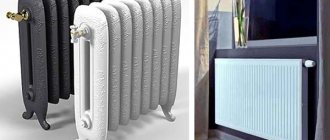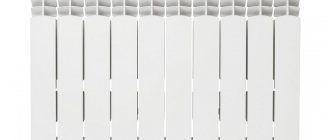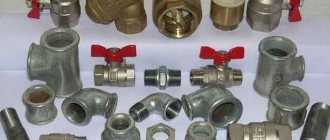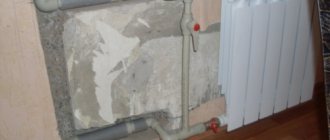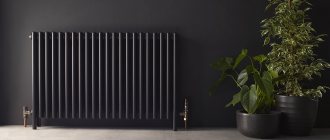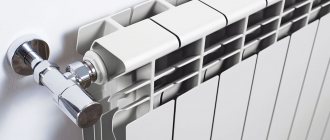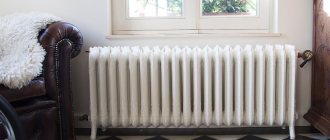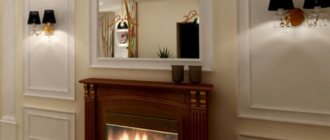The aesthetic appearance and technical characteristics of such heating devices allow them to be used in private houses, apartments, schools, hospitals, kindergartens or industrial buildings.
To choose the right heating device, you need to know that individual types of aluminum radiators may differ in design, number of sections, production method and technical characteristics. Moreover, they all have a number of obvious advantages compared to their cast iron predecessors.
Aluminum heating radiators: types and characteristics
There are three main types of aluminum radiators. Despite the same raw materials, manufacturing technology and degree of purification lead to significant differences in performance characteristics, and therefore in the specific application of these batteries.
Die cast
The raw material is high-silicon alloy EN AB 46100 (AlSi9Cu2(Fe)), where the silicon (Si) content should not exceed 10-12%. European and most domestic manufacturers use certified primary aluminum in the manufacture of such radiators. This makes it possible to obtain products with the declared strength characteristics and reduce the risk of corrosion processes. In contrast, almost all Chinese manufacturers use recycled aluminum obtained from scrap. This results in a low-quality alloy, and the radiators themselves, compared to the standard, turn out to be more fragile. In addition, due to the high porosity of the material, heat transfer is significantly reduced. At the moment, radiators made of die-cast aluminum are the most popular in the Russian market.
Die-cast, regular and reinforced version
Extrusion sectional
Unlike cast ones, the production technology of extruded aluminum radiators involves the production of individual elements of sections, as well as the upper and lower manifold separately. Although each part is stronger, multiple joints significantly reduce the overall strength of the product. In addition, some manufacturers, to reduce the cost of the production process, use composite glue rather than argon welding during assembly. The likelihood of leaks in such batteries is much higher, even at standard operating pressure. It should be noted that many sellers pass off extrusion radiators as high-pressure cast ones. It is quite easy to distinguish such products. By the presence of characteristic seams at the junction of the ribs and collectors.
Extruded aluminum heating radiator in section. The connection lines of the elements are clearly visible
Anodized
Made from high purity aluminum (up to 98%). The technology involves anodic oxidation of the entire internal working surface of the radiator. Oxidation changes the structure of the metal surface, as a result of which the product receives protection from almost any type of corrosion. The main technical characteristics of anodized aluminum radiators are significantly higher than those of previous varieties. However, this manufacturing technology is quite expensive, which affects the cost of the final product. Therefore, anodized aluminum radiators have not found wide distribution on the Russian heating products market.
Anodized aluminum radiators
A comparative analysis of the main technical characteristics of aluminum radiators of various types is given in the table.
| Radiator type | Performance characteristics | ||
| Working pressure, atmospheres | Maximum temperature, ºС | Heat dissipation (for one section), W | |
| Die cast | 16-20 | 110 | 100-150 |
| Sectional extrusion | 10-40* | 110*** | 80-100 |
| Anodized | 215** | 140 | 150-200 |
* - In practice, the amount of “return” on extrusion radiators is much greater than on cast ones.
** - Most manufacturers of anodized radiators indicate the maximum pressure to destroy one section. However, prefabricated connections significantly reduce this figure. As a rule, the working pressure does not exceed 50-60 atm.
*** — Extruded sectional radiators assembled using composite gluing technology have a much lower maximum temperature threshold, no more than 85-90ºС.
Anodized radiators can also be produced in the form of panels with a fairly wide selection of standard sizes
Related article:
Which heating radiators are best for an apartment . In this publication we will look at the types of radiators, their advantages and disadvantages, selection criteria, how to correctly calculate the number of radiators and how to install them correctly.
Aluminum die-cast batteries
The price of injection molding equipment is higher. During its production, each section is cast under pressure from silumin - the name of an aluminum alloy that contains about 12% silicon to enhance strength.
All components of injection molding devices are connected by welding in an inert gas atmosphere. This technology for the production of aluminum radiators makes the equipment more durable. Products having the required thermal power are assembled from separate sections.
The advantages of such devices:
- the presence of sealed connections;
- the ability to add or subtract the number of sections.
Their main disadvantage is their high cost.
Advantages and disadvantages of use
Aluminum radiators have become widely popular due to their undeniable technical and operational advantages:
- high heat transfer with relatively compact dimensions;
- light weight, greatly facilitating transportation and installation;
- good ratio of cost and heat transfer power;
- aesthetic appearance and durable protective coating (no need for periodic painting).
There are certain technical limitations:
- low resistance to high pressure, especially to water hammer during pressure testing of the heating system;
- sensitivity to coolant quality.
It should be noted that anodized aluminum radiators are completely devoid of these disadvantages.
Decorative design of aluminum radiators using a grille
Special attention should be paid to such a parameter as thermal inertia. On the one hand, unlike cast iron radiators, aluminum radiators will not be able to maintain heat in the room after the boiler is turned off. On the other hand, this gives the widest possibilities for monitoring and managing the temperature in the room. Ultimately, the widespread use of heat regulators and the economic effect of their use turn the low thermal inertia of aluminum radiators into an advantage.
Manufacturers offer various color solutions that fit perfectly into the interior.
Classification by type of coolant circulation
According to the method of creating liquid circulation, private heating systems are divided into two types: gravity (with natural circulation) and pumping (with forced movement).
Before installation, you should take into account the operating principles of each equipment and select the most suitable one for the building conditions.
Natural circulation systems
The natural movement of water is caused only by physical processes. Liquid moves under pressure.
With the correct layout of such a system, heating will depend only on the natural water pressure. Failures, if all conditions are met, are extremely rare.
Features of application
As already mentioned, aluminum and its alloys used in the manufacture of radiators are highly sensitive to the quality of the coolant. Namely, to its acidity. The normal acidity of the coolant should be within pH=7-8. If there is a deviation from the norm, the protective oxide film is washed away, and as a result of the formation of a new one, hydrogen is released (champagne effect). This causes a lot of troubles, ranging from the formation of air locks to battery failure due to accelerated corrosion. This is especially noticeable in the summer months, when the coolant is drained from the general system and the pipelines are clogged. A large amount of hydrogen released simply ruptures the housing from the inside.
Using a radiator with insufficient strength in a city apartment
When choosing aluminum radiators, it is also necessary to take into account the operating pressure in the system. For centralized networks, the standard is 10-15 atmospheres. However, this is the working pressure. When starting up and checking heating systems for leaks, the pressure test is increased to 1.5-2 times. Thus, for apartments with a centralized system, only anodized aluminum radiators are allowed.
Aluminum radiators are sold in a wide range of standard sizes. In addition, you can independently add and remove sections, optimizing the heat transfer of the battery
In individual heating systems, the operating pressure rarely exceeds 1.5-2 atm. Therefore, any type of aluminum radiators can be used there.
Galvanic couple effect. There is a fairly well-founded opinion among thermal engineers and installers that aluminum radiators cannot be used in conjunction with boilers that are equipped with copper heat exchangers. The reason is the formation of a galvanic aluminum-copper pair, leading to electrochemical corrosion. If it is formed, copper attracts aluminum ions, and, within just a few years of operation, the aluminum on the radiator turns into foil.
Galvanic couple effect. Intense hydrogen release can not only destroy batteries, but also cause a fire
However, this effect can only be achieved in the case of direct contact between copper and aluminum. If PVC pipes are used to transfer coolant or special cadmium-plated, chrome-plated or nickel-plated adapters are used during installation, the galvanic couple is broken.
Video description
How to choose a heating radiator.
Cast iron
The 50+ generation remembers that when they heard the word “battery,” they usually associated it with a cast-iron radiator in an apartment, and occasionally in a private house—it’s just that there weren’t any others back then, except for homemade steel registers made from pipes. Cast iron, as a metal, has one interesting feature; The higher the temperature of the coolant, the lower its thermal conductivity. This is bad? Not really. If you live in a multi-storey building and are connected to centralized heating, you will notice that water is not constantly circulated through the system and this is due to the material of the heating circuit.
Cast iron batteries retain heat for a long time when the water circulation is turned off, that is, the hot water that fills the sections cools down for a very long time, since it does not give up its energy to the shell immediately, but in parts. It turns out that the more the coolant cools, the faster it gives up its heat to the radiator, but it does not have time to cool completely, since at this time the circulation pump motors start again. This system is very convenient for multi-storey buildings and somewhat expensive for the private sector with autonomous boiler houses. The maximum pressure that cast iron batteries can withstand ranges from 25-30 atmospheres - this is enough for short-term pressure testing. The thermal conductivity coefficient is 62.8 W/(m*deg).
Manufacturers: black and white list
Of the main manufacturers whose products are deservedly popular, many Italian companies can be noted:
- Global;
- Fondital;
- Nova;
- Florada;
- Radiatori;
- Sira.
Nami also deserve attention .
Among domestic companies, it is worth noting radiators from Ankor , Rifar (under Global license) and Thermal .
Some Chinese manufacturers operating under a Global license were also included in the white list: Alltermo , Tianrun .
Also, we would like to draw your attention to the list of companies (mostly Chinese), about whose products we found the most negative reviews:
- Oasis;
- Conner;
- Radena;
- Warma.
In addition, during tests carried out in 2021 in the Moscow Vitaterm laboratory, discrepancies between real parameters and declared indicators from 22% to 34.75% were found in the products of the listed companies.
Popular models and reviews of them
The editors of HomeMyHome present to your attention some consumer reviews of the most popular models of aluminum radiators:
Feedback on the use of aluminum heating radiators “Lammin”:
More details on Otzovik: https://otzovik.com/review_7663127.html
Aluminum heating radiators Lammin
Review of the aluminum radiator “Konner”:
More details on Otzovik: https://otzovik.com/review_7043504.html
Review of the aluminum radiator “Royal Thermo Evolution 350”:
More details on Otzovik: https://otzovik.com/review_4064173.html
Royal Thermo Evolution 350
Review of the aluminum radiator “Mirado Al 500/96”:
More details on Otzovik: https://otzovik.com/review_4043505.html
Feedback on the operation of the Monlan radiator:
More details on Otzovik: https://otzovik.com/review_4154747.html
Selection criteria and calculation of the number of sections
When choosing an aluminum heating radiator, pay attention to the following parameters:
- the presence of a protective oxide film or additional treatment on internal surfaces;
- mandatory availability of a technical passport for the product indicating the main technical characteristics;
- the seller has a certificate of conformity to prevent the purchase of counterfeit products;
- As a rule, prefabricated heating radiators are supplied in 10 sections. Some manufacturers offer radiator options from 3 to 15 sections. Remember that factory assembly is more reliable than one made at home. Therefore, it is advisable to purchase batteries assembled;
- if, according to calculations, a radiator with a number of sections exceeding 10 is needed to heat the room, then it is more efficient to purchase two batteries with the corresponding number of sections;
- Most European manufacturers are very jealous of the quality of their products, so they order various examinations. The presence of an independent test report is a significant advantage of this manufacturer’s products.
Additional parameters of the form factor of an aluminum heating radiator
Important! It is strictly not recommended to purchase aluminum radiators (mainly made in China) marked NF/68/. Research by the independent laboratory AIRAL has revealed a critical asbestos content in such products.
Temperature control
When determining the number of sections for heating a room, the following nuance must be taken into account. Manufacturers indicate the heat transfer rate of one section at a certain temperature. As a rule, it is 70-75ºС. However, in most cases, the temperature of the coolant in heating systems rarely rises above 60ºC. Therefore, the indicator indicated in the technical passport must be reduced by 15-20%.
Correct location in the niche under the window
Features of self-installation of aluminum heating radiators
If the heating system pipes have appropriate threaded fittings, then replacing any radiators with aluminum ones can be done with your own hands:
- first of all, it is necessary to shut off the heating circuit and drain the water;
- on the purchased radiator you need to find the plugs and pull them out;
- If the heating system is single-pipe, a bypass must be installed. If it is two-pipe, then you can do without it;
- to connect the radiator, it is used in a fitting with a valve, which is screwed on using pipe wrenches;
- To seal the threaded connection, tow or more modern sealing materials are used: Unipack, silicone tape, etc.;
- The packaging shell is removed only after all installation work is completed, which will protect against damage to the front panel.
For positioning on the wall, it is better to purchase brackets with the ability to adjust the height of the position
Securing the radiator with a pipe wrench
Methods for installing heating equipment
The connection of all elements of the heating structure can be carried out in different ways. According to the method of installation to the main line, radiator heating systems can be:
The vertical system has a bottom-up connection. The heating elements of all floors in the building are carried to one riser. This method is effective, but expensive.
The horizontal system is used in buildings with one floor. The room usually has a large area, so the heating design must be complex. Radiators are connected along a horizontal path. The distribution of risers is placed in the corridor or entrance.
